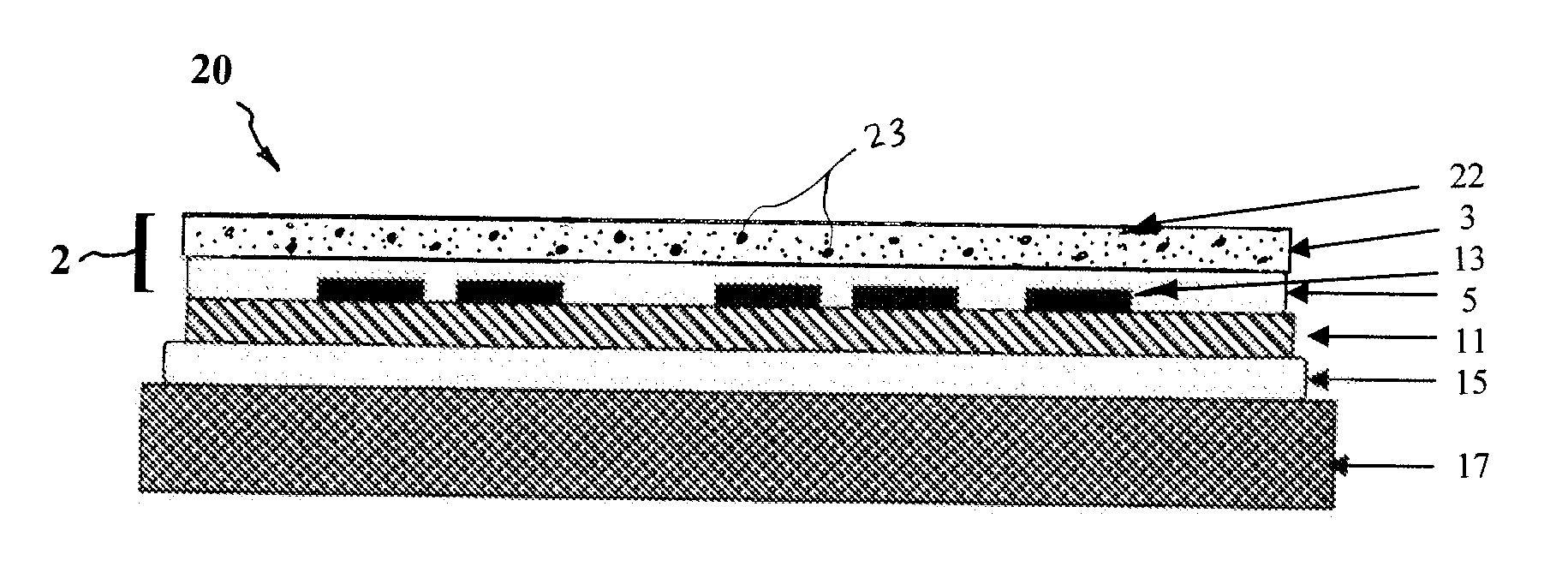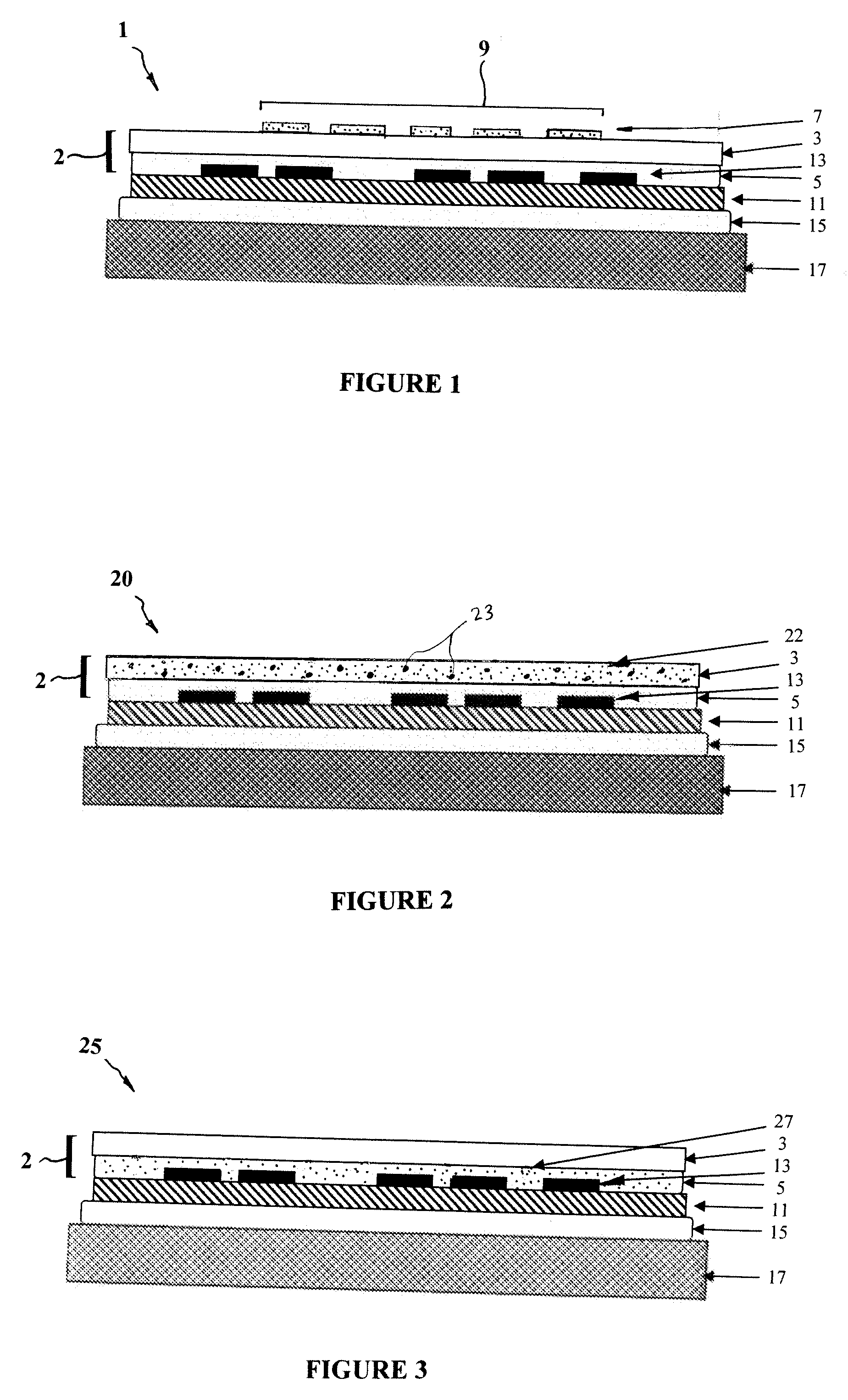Security label laminate and method of labeling
- Summary
- Abstract
- Description
- Claims
- Application Information
AI Technical Summary
Benefits of technology
Problems solved by technology
Method used
Image
Examples
example 1
[0039]Thermal transfer ribbon is prepared with a UV excitable material, UVXPBR. This particular material has the property of emitting red visible light after excitation with UV light, as described at www.maxmax.com. The UVXPBR is mixed with a clear resin (15% resin, 85% solvent, primary component 2-butanone) at a concentration of 1000 parts per million (ppm). This is accomplished by dissolving 0.03 g UVXPBR in 30 g resin solvent mixture and stirring to solution at room temperature. The resulting clear solution is hand coated on pre-slit 4″ wide thermal transfer ribbon with a number 4 Mier rod. Coated thickness after solvent evaporation is about 1 micron and the marker content in the resin is about 6667 ppm. Several hand coatings are completed in series and the ribbon is wound, coated side out, on a new 1″ core.
[0040]The freshly prepared ribbon was threaded onto a Zebra model ZM400 thermal transfer printer. Along with this ribbon, 1″ round clear label laminates 2 produced by laminati...
example 2
[0049]A thermal transfer ribbon is prepared with A-225 up-converting IR excitable material available from Epolin, Inc. This particular material has the property of emitting green visible light after excitation with IR light, as described at www.epolin.com. The A-225 material is mixed with a clear resin (15% resin, 85% solvent, primary component 2-butanone) at a concentration of 1000 ppm. This is accomplished by mixing 0.03 g A-225 with 30 g resin solvent mixture and vigorously stirring to dispersion at room temperature. The resulting mixture is hand coated on pre-slit 4″ wide thermal transfer ribbon with a number 4 Mier rod. Coated thickness after solvent evaporation is about 1 micron and the marker content in the resin is about 6667 ppm. Several hand coatings are completed in series and the ribbon is wound, coated side out, on a new 1″ core. The freshly prepared ribbon is threaded onto a Zebra model ZM400 thermal transfer printer. Along with this ribbon, 1″ round clear labels, prod...
example 3
[0052]In this example, an IR absorbing dye was dissolved in 2-butanone, then mixed into a removable acrylic adhesive mixture at a concentration of 5000 ppm. The dye used was FHI9072, described on www.fabricolorholding.com. The adhesive mixture was coated on 2-mil polyester film to a thickness of 1 mil., thus forming the adhesive layer 5 of a label laminate 2. This resulted in a marker concentration of 12.5 microgram / cm2. The resulting label laminate 2 was then adhered over a polyester label substrate 11 and die-cut to shape. The resulting label 1 had no apparent visible colorations due to the IR dye.
[0053]Detection of the dye was accomplished via IR reflectance. The light source 40 was a digital Nikon 995 camera modified to remove the IR filter that normally covers the CCD array. The reader 42 used was a digital Nikon 995 camera in which a 650 nm long pass filter was placed in front of the lens in order to reduce noise in the signal. The camera was placed in a tripod approximately 2...
PUM
 Login to View More
Login to View More Abstract
Description
Claims
Application Information
 Login to View More
Login to View More - R&D
- Intellectual Property
- Life Sciences
- Materials
- Tech Scout
- Unparalleled Data Quality
- Higher Quality Content
- 60% Fewer Hallucinations
Browse by: Latest US Patents, China's latest patents, Technical Efficacy Thesaurus, Application Domain, Technology Topic, Popular Technical Reports.
© 2025 PatSnap. All rights reserved.Legal|Privacy policy|Modern Slavery Act Transparency Statement|Sitemap|About US| Contact US: help@patsnap.com



